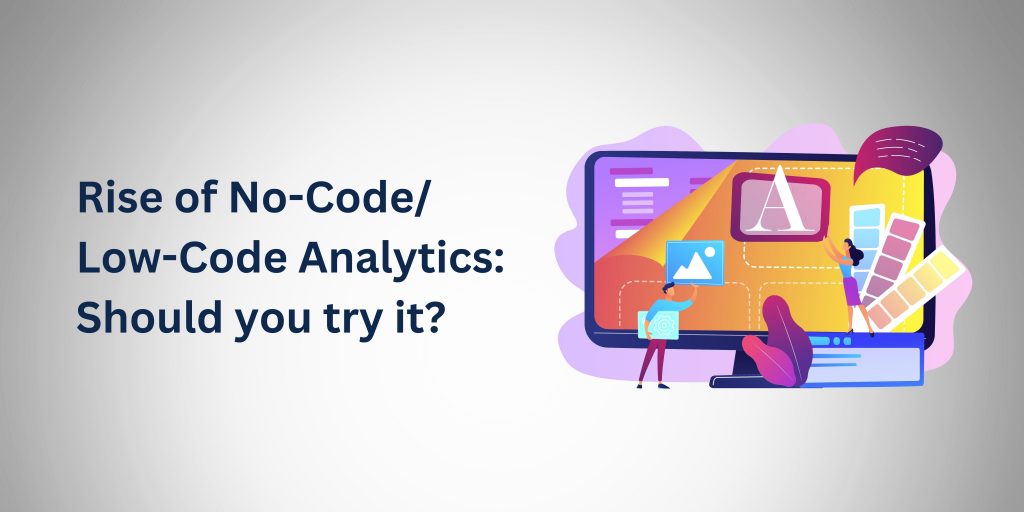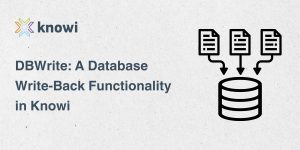No-code/low-code platform evolution represents a paradigm shift in how and who can access data. Traditionally, data analysis has been the onus of technical data teams. These teams were centralized and were working for multiple business stakeholders. This resulted in them being always swamped with data related queries and simple queries by business stakeholders took days and months to get answered.
No-code/low code platforms are a way to solve these issues. Business users or users with low technical know-how, called “citizen developers”, can now work on their data without relying on data teams to answer their simple questions.
The global market for low-code platforms is predicted to reach $187 Billion by 2030. It is forecasted to grow at a CAGR of 31.1% for 2020 – 2030. It is also anticipated that by 2025, organizations will build 70% of their new applications/platforms using low-code or no-code platforms. This is up from less than 25% in 2020.
What is a no-code platform?
No-code platforms allow users to build data analytics solutions entirely through visual interfaces. These interfaces typically involve drag-and-drop functionality, pre-built components, and visual workflows, making them accessible to users without any coding knowledge.
- Drag-and-Drop Interfaces: Users can build their dashboards using visual elements like pre-built components that can be dragged and dropped onto a workspace. This intuitive method allows users to design complex data visualizations and reports without needing to write any code.
- Visual Workflows: Users can define the flow of their analytics processes by connecting components with arrows or lines, specifying how data should move between them. This visual approach simplifies the creation of data pipelines, transformations, and analyses.
- Pre-built Templates: Many no-code platforms offer a library of pre-built templates for common data analytics applications, such as sales dashboards, marketing analytics, and financial reporting tools. These templates provide a great starting point, enabling users to quickly set up and customize their analytics solutions.
What is low-code?
Low-code platforms provide visual interfaces similar to no-code platforms but also allow for some coding to enable more complex functionalities. They offer pre-built components and workflows, with the additional option to add custom code to meet specific needs.
- Visual Interfaces with Coding Options: While users can build data analytics solutions using drag-and-drop components and visual workflows, they also have the flexibility to incorporate custom code for more advanced analytics or unique requirements.
- Pre-built Components and Workflows: Like no-code platforms, low-code platforms come with a variety of pre-built components and workflows. These elements streamline the creation of data dashboards, reports, and analytics processes, but with the added advantage of customization through coding.
Why are they increasingly becoming popular
No-code/low-code platforms are becoming popular for several reasons:
- Ease of Use for Non-Technical Users: They allow non-technical users, or “citizen developers,” to create custom analytics without writing code, lowering the barrier to entry for data analysis and insights.
- Addressing Developer Shortages: With a global shortage of high-code developers, no-code/low-code platforms help fill the gap by enabling non-developers to build analytics dashboards, reducing dependency on expensive technical expertise.
- Cost and Time Efficiency: No-code/low-code solutions offer significant time and cost savings by allowing businesses to develop analytics more quickly and without the need for specialized programming skills.
- Scalability and Production-Readiness: Modern no-code/low-code platforms can create scalable, production-ready analytics solutions that can meet the needs of growing businesses.
- Rapid Response to Business Needs: They enable faster responses to business needs and market changes, as analytics solutions can be developed and modified quickly.
- Increased Adoption by Large Enterprises: Large enterprises are increasingly adopting no-code/low-code tools to lower development costs, speed up time-to-market, and enhance agility, especially during economic downturns.
- Improved Security and Governance: No-code/low-code platforms are prioritizing security with built-in features like data encryption and role-based access controls, making them more attractive for developing critical analytics solutions.
- Integration Capabilities: These platforms offer seamless integration with various applications and systems, enhancing interoperability and data flow across departments.
- Customization and Flexibility: No-code/low-code tools allow users to create highly customized analytics solutions tailored to their specific needs without requiring extensive coding knowledge.
- Open-Source Alternatives: The availability of open-source no-code/low-code tools provides more options for organizations with strict IT and compliance requirements, making these platforms more accessible and versatile.
Low-code vs. no-code
The choice between low-code and no-code platforms largely depends on your specific needs and the technical expertise of your team. Here’s a detailed comparison to help you understand which type of platform may be best suited for your project:
Team Skills
- No-code: Ideal for beginners and non-technical users. These platforms are designed to be highly intuitive with drag-and-drop interfaces and pre-built templates, enabling users with little to no programming experience to create analytics solutions.
- Low-code: Suitable for a mix of technical and non-technical users. While low-code platforms also offer visual development environments, they provide more flexibility and options for customization through coding, making them a better fit for teams that have some programming knowledge.
Project Complexity
- No-code: Best for simpler applications and analytics solutions. No-code platforms are excellent for quickly developing straightforward projects that don’t require complex integrations or extensive backend logic.
- Low-code: Better for more intricate functionalities. If your project requires advanced features, complex workflows, or integration with multiple systems, a low-code platform provides the necessary tools and flexibility to handle such complexities.
Customization Needs
- No-code: Suitable for basic needs where minimal customization is required. No-code platforms come with predefined modules and components that can be easily configured but offer limited customization beyond what is available out-of-the-box.
- Low-code: Ideal for projects that demand greater control over the final product. Low-code platforms allow developers to add custom code and tailor solutions to specific requirements, providing a higher degree of customization and flexibility.






